For many businesses, social media marketing strategy is the most important piece of the overall marketing performance.
Social media is used by people across the world, and it is, therefore, one of the best channels for reaching new customers, generating sales, increasing brand awareness, and building trust among prospects.
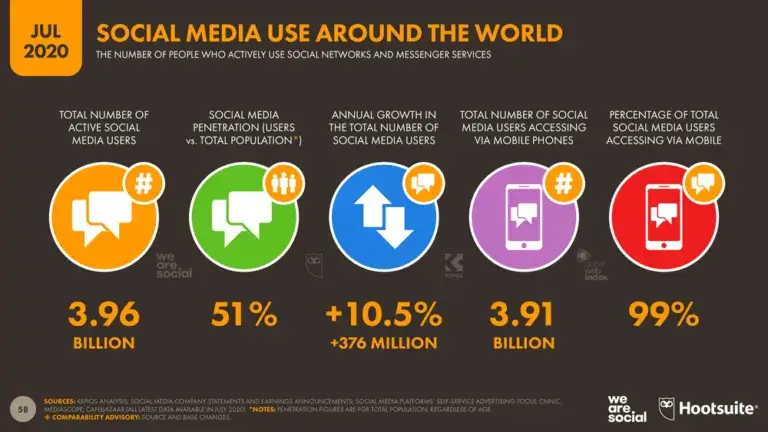
Since both B2B and B2C companies are always trying to find new ways to better leverage social media in their overall marketing strategies, in this blog we will cover the best practices for defining, implementing, and managing your social media marketing strategy.
Boost your SoMe strategy with the right employee advocacy tools
Why Should Your Define Your Social Media Marketing Strategy
There are many different social media channels today, and their number is continuously increasing. Take Tik Tok for example – one of the newest social media networks that already has 800 million users worldwide.
According to research, almost 4 billion people across the world use social media, and this number keeps increasing every year. Furthermore, due to the COVID-19 pandemic, we are witnessing a spike in social media usage worldwide.

In order to get the most out of these social media networks, it is important that social media professionals understand their differences, benefits, disadvantages, capabilities, features, and functions.
Moreover, in order to align social media marketing strategy with the ultimate business goals, it is crucial to follow certain steps for building a strong social currency.
Let’s take a look at these steps.
How to Create a Perfect Social Media Marketing Strategy
Planning and implementing a social media marketing strategy is a never-ending process. Even though every business’ SM strategy may be different, there are certain steps that social media teams should follow.
Now, we will go over the steps for creating a successful social media strategy that brings business results.
📚 Before we move forward, check out our article about the benefits of brand advocacy and how to leverage it on social media.
1. Define your target audience
When building a social media marketing strategy, the first step should be defining your buyer persona and your target audience. Your buyer persona is a fictional representation of your perfect customer.
In order to be successful in all the following steps, it is crucial that you understand who are you targeting and what are the characteristics of your target audience.
Even though there are many different templates for creating your personas, this set of questions defined by Buffer is all you need.
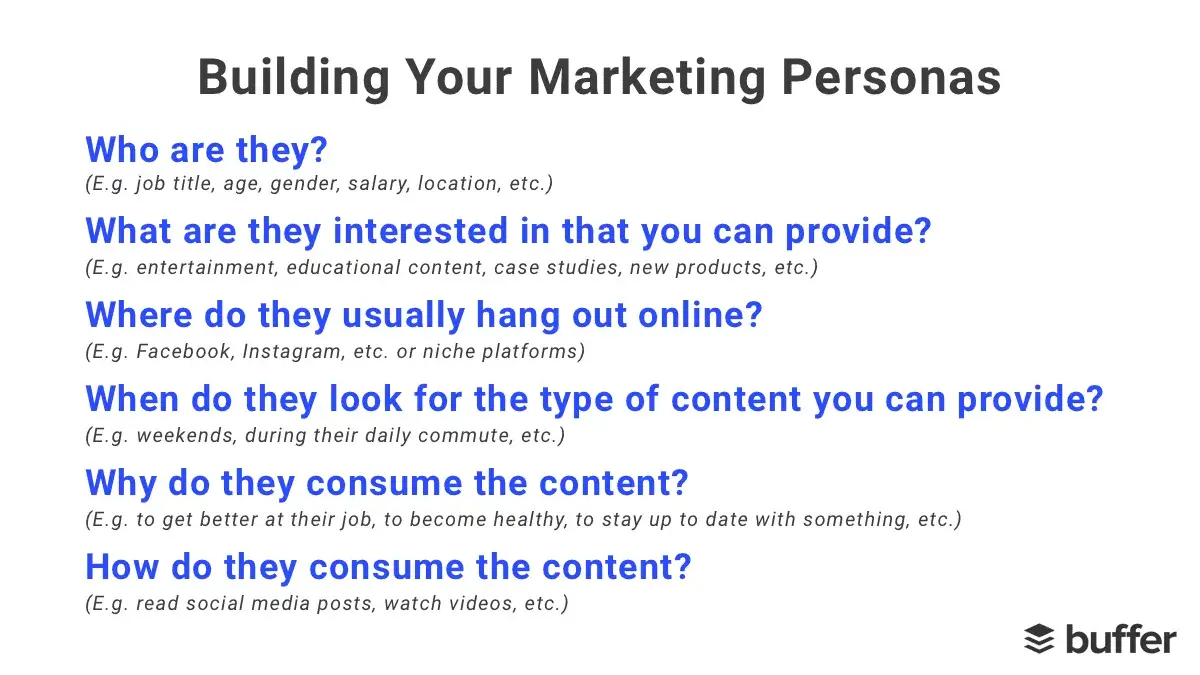
💡 Extra tip: Remember that you may have more than one persona that you want to target on social media. When you use SM to generate more sales, your persona will be much different than if you use it for employer branding.
Therefore, every social media department should work closely with other departments such as sales, marketing, product, and HR, and use their insights and knowledge about different target audiences.
📚 Related: Why Your Target Audience Isn’t Reading Your Content.
2. Set clear goals and KPIs
Every successful marketing strategy has a clear set of goals and objectives. It is important to define SMART goals in order for marketers to track the success of their campaigns and prove the benefits of their investments.
Social media KPIs may differ significantly based on the industry you are in. Moreover, B2B business may have very different objectives compared to B2C businesses, and this is due to different buyer personas.
The following image represents the most common social media goals.
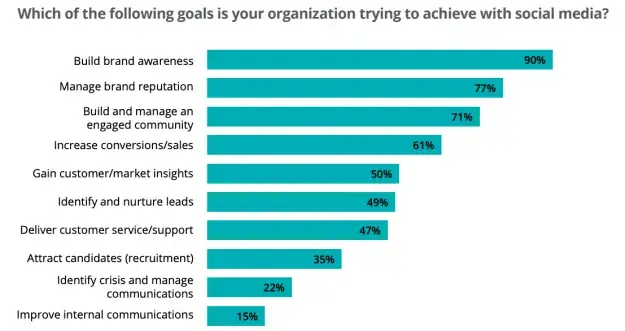
Source: Hootsuite
💡 Extra tip: When defining KPIs, you should be more specific than the above mentioned goals, and your goals should be SMART (specific, measurable, attainable, relevant, and time based).
Here are just a few examples:
- Increase website traffic from social media by X% in quarter X
- Increase engagement (likes, comments, shares) on social media by X% in year X
- Increase conversion on social media by X% in the next quarter
- Increase the number of sales and marketing qualified leads by X% in the next year
3. Create and curate engaging content
When you know your buyer personas and which social media platforms they use, it is much easier to create and curate content your audience will engage with.
For example, if you are in B2C industry and targeting Millennials and Gen Z, video content on YouTube may be your best bet.
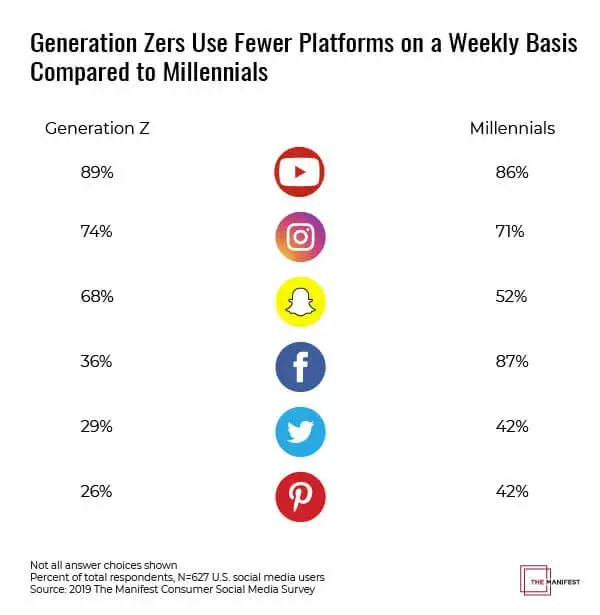
If you are in B2B industry, many of your buyer personas are probably on LinkedIn, and your content should be more like:
- Post about issues that are relevant to your buyer persona.
- Posts about best practices relevant to your buyer persona.
- Post about real problems that people are facing.
- Post about research in your industry.
- Image posts with real people faces.
💡 Extra tip: In order to better understand what type of content resonates with your audience, make sure that you always measure the performance of your social media posts and campaigns. Hence, consider A/B testing to identify the type of content your buyer personas engage the most with.
📚 Related: As proper communication is essential for every successful SM strategy, check out our blog about top 5 communication skills.
4. Focus on the social media networks that best fit your strategy
Social media trends change all the time.
This is why social media teams need to identify SM channels that best fit their goals and bring them the most profits. Moreover, different social media channels used by the same company may have completely different KPIs and target completely different personas.
By using marketing tools such as Google Analytics, it is easy to identify social media platforms that bring the most value for your organization. If you see, for example, that LinkedIn drives much more traffic to your website than Instagram, then invest more of your resources into that channel.
💡 Extra tip: If you are using social media for both marketing and employer branding, consider creating two different profiles. Instagram is the best example of a platform that many organizations use for both marketing and talent attraction initiatives.
Here is an example of HubSpot’s profile used for marketing and sales purposes.
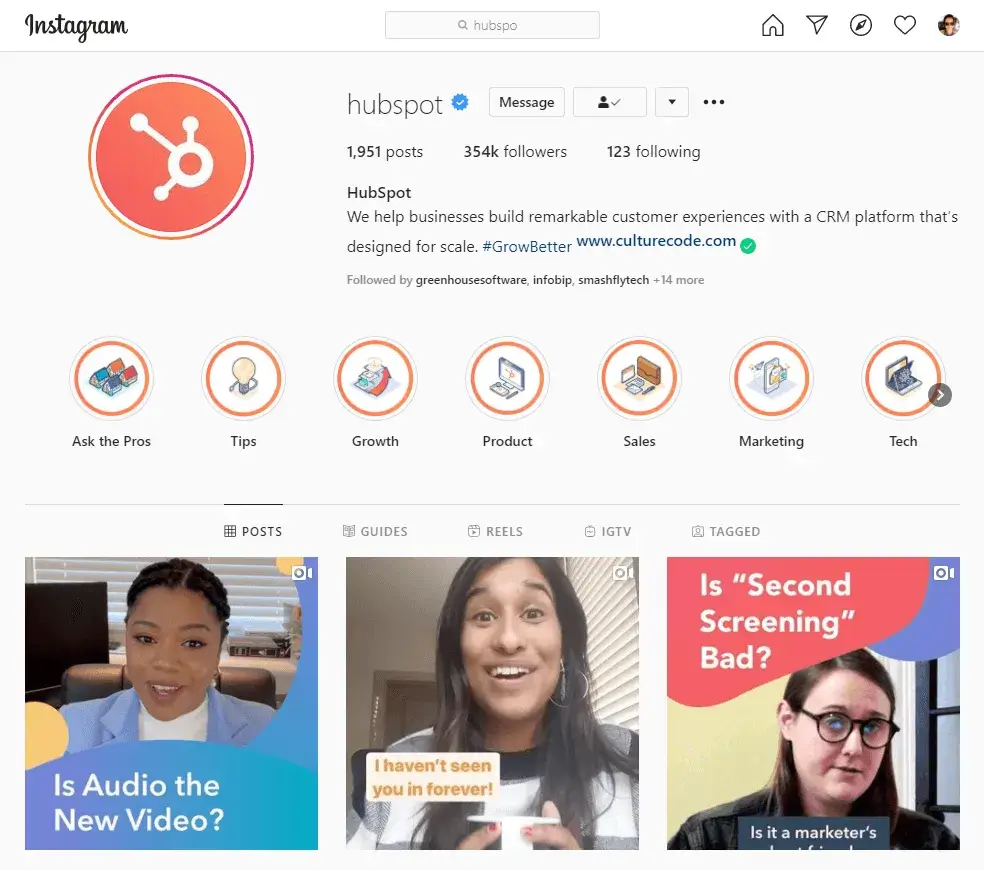
And here is an example of HubSpot’s Life profile that focuses on showcasing HubSpot as an employer with posts and stories around HubSpot’s workplace culture, EVP, and core company values.
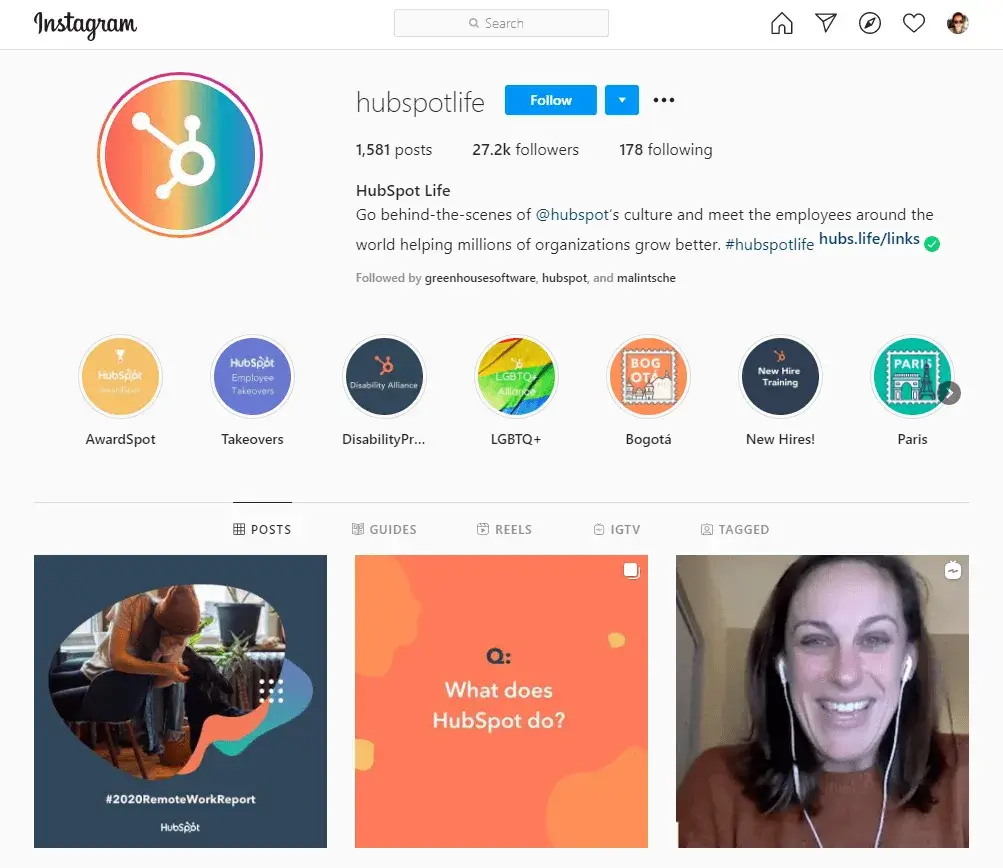
📚 Related: Guide for Building a Great EVP.
5. Research your competitors
An important part of every social media marketing strategy is researching what your biggest competitors are doing on social media. There are big odds that your competitors are already using social media, and that means you can learn from what they’re doing.
Luckily, there are great social listening tools that make competitive analysis much easier and faster. They can track your competitors’ activities in real time and offer great insights into what kind of posts and which social and communication channels are bringing the best results.
💡 Extra tip: When your realize that your competitor is more active on one social media than others, this may be an opportunity for you to reach your audience where it’s underserved. Rather than trying to win fans away from a dominant player, consider leveraging those untapped opportunities.
6. Engage with your followers
Once you schedule or publish your posts on social media, your job is not done. Moreover, your followers’ engagement with your posts is what drives more visibility. This is why it is crucial that social media teams continuously monitor performance and engage with the followers. With many social media platforms, like Facebook, you can leverage auto-reply to comments to ensure timely responses and maintain an active and responsive online presence.
💡 Extra tip: Many organizations are doing a great job leveraging user-generating content and empowering customers to be their brand advocates.
As your customers’ words are considered as much more trustworthy than your corporate brand’s, user-generated content is the best way to increase your followers’ engagement on your social media channels. Whether it’s using a hashtag or posting a photo, encouraging customer or employee content is a smart move for boosting engagement rate.
Moreover, 50% of consumers say that seeing user-generated content would increase their chances of buying products through a brand’s social media.
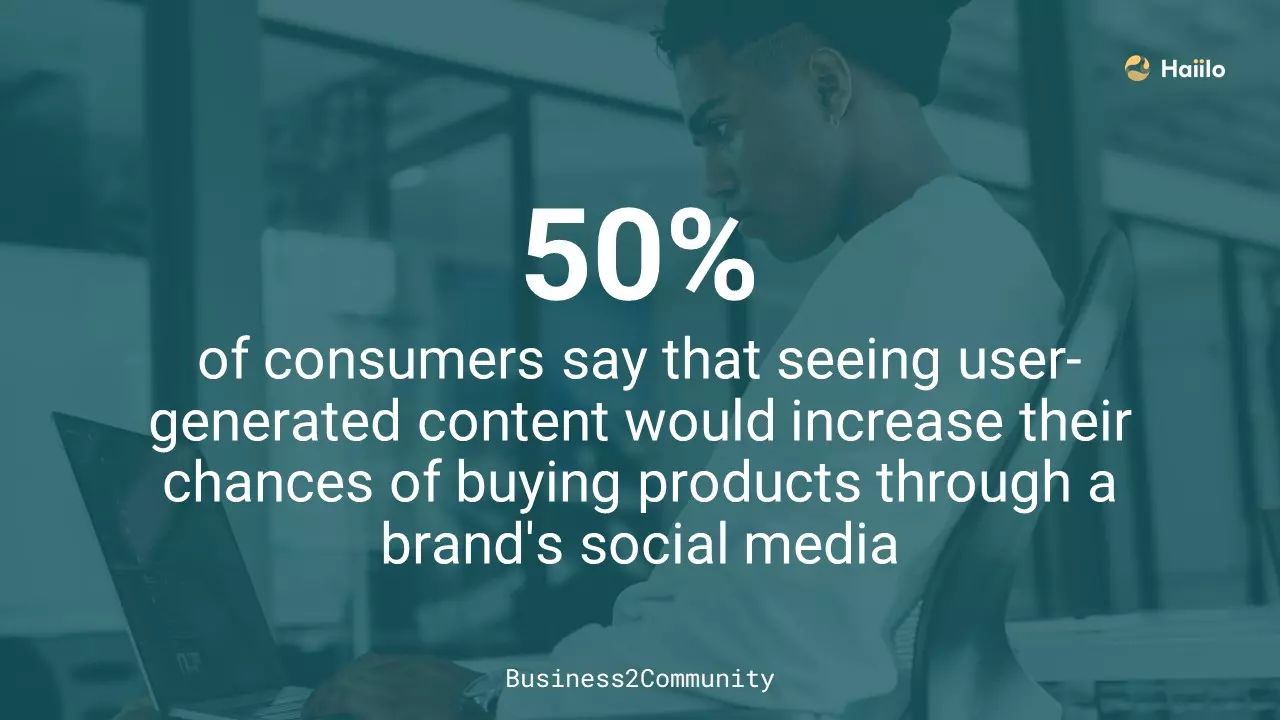
7. Make employees your brand advocates
In the previous section, we briefly introduced brand advocacy. Even though your brand advocates can be various influencers, customers, partners, and other stakeholders, your own employees can be your best brand advocates.
Yet, this type of brand ambassadorship is one the most underused social media marketing tactics. However, the fact that social media content shared by employees gets 8 times more engagement than content shared through the brand’s own social channels is the reason why more and more SM departments have started to leverage employees’ existing networks to boost their marketing performance.

💡 Extra tip: Even though there are many different advocacy solutions out there, not many of them focus on employee advocacy. If you are considering implementing an employee advocacy program in your organization, a modern, intuitive, and mobile-first employee advocacy solution is your best bet!
8. Test, measure, and improve
It goes without saying that every social media marketing activity should be measured and assessed. This is the only way for social media professionals to better understand what’s working well and what is not.
Based on such insights, they can adjust their social media strategy and make data-driven decisions for improvement.
💡 Extra tip: Besides just tracking your own and your competitors’ performance on social media, consider doing a deep hashtag analysis. Growing your audience on social media also means discovering conversations around your industry that matter the most, for which finding specific keywords, phrases, or hashtags is crucial.
Moreover, if your employees are participating in your advocacy programs, make sure that you can measure the exact ROI of their engagement.
7 Benefits of Social Media Marketing
It is undeniable that social media is a must-have marketing strategy across all businesses and industries. This is not surprising as 73% of marketers believe that their efforts through social media marketing have been “somewhat effective” or “very effective” for their businesses.
Brands are continuing to include social media in their marketing strategy – and for all the right reasons.
Let’s take a look into some of the most common reasons why companies invest in social media.
1. Brand awareness
For many business, social media channels are used to increase brand awareness and build trust among prospects and existing customers. According to research, 44% of local businesses say they depend on social media to generate brand awareness, and 41% depend on it to drive revenue.
📚 Related: How to Measure Brand Awareness.
2. Website traffic
Social media platforms are one of the leading sources of website traffic. According to 90% of marketers, their social media marketing efforts have increased the exposure of their business, and 75% say they’ve increased website traffic.

3. SEO
Social media engagement is one of the off-site SEO components of the Google’s Ranking Algorithm. In other words, more engagement on your social media profiles can go a long way in improving your SEO and organic rankings on search engines.
4. Sales
For some businesses, social media is the most efficient source of new leads and customers. This is especially true for B2C companies. Moreover, 21% of consumers are more likely to buy from brands that they can reach on social media, and according to GlobalWebIndex, 54% use social media to research products.
5. Customer loyalty and advocacy
According to another research, 71% of consumers who have had a positive experience with a brand on social media are likely to recommend it to their friends and family. Therefore, many organizations use social media to build a base of loyal customers and brand advocates.
6. Conversion rates
Some social networks have great conversion rates which is why they are used for lead generation. HubSpot analyzed more than 5,000 businesses that use Facebook, Twitter, and LinkedIn to generate leads. The results were astonishing.
LinkedIn dominated the visitor-to-lead conversion rate with an impressive 2.74%. Facebook and Twitter were far behind with rates below 1%.
Therefore, marketing and social selling on LinkedIn are considered some of the most powerful B2B tactics for generating new leads and closing new customers.
7. Cost effectiveness
Social media advertising can be much more cost-effective compared to other forms of advertising such as Google Ads. According to research, cost per lead on LinkedIn is 28% lower compared to Google Ads, and it offers incredible targeting capabilities that are particularly useful for B2B businesses.

The Role of Employees in Boosting Your Social Media Marketing Strategy
Earlier, we briefly mentioned the importance of including your own employees in your social media strategy. Having employees as brand advocates has many benefits, and here are the most important ones.
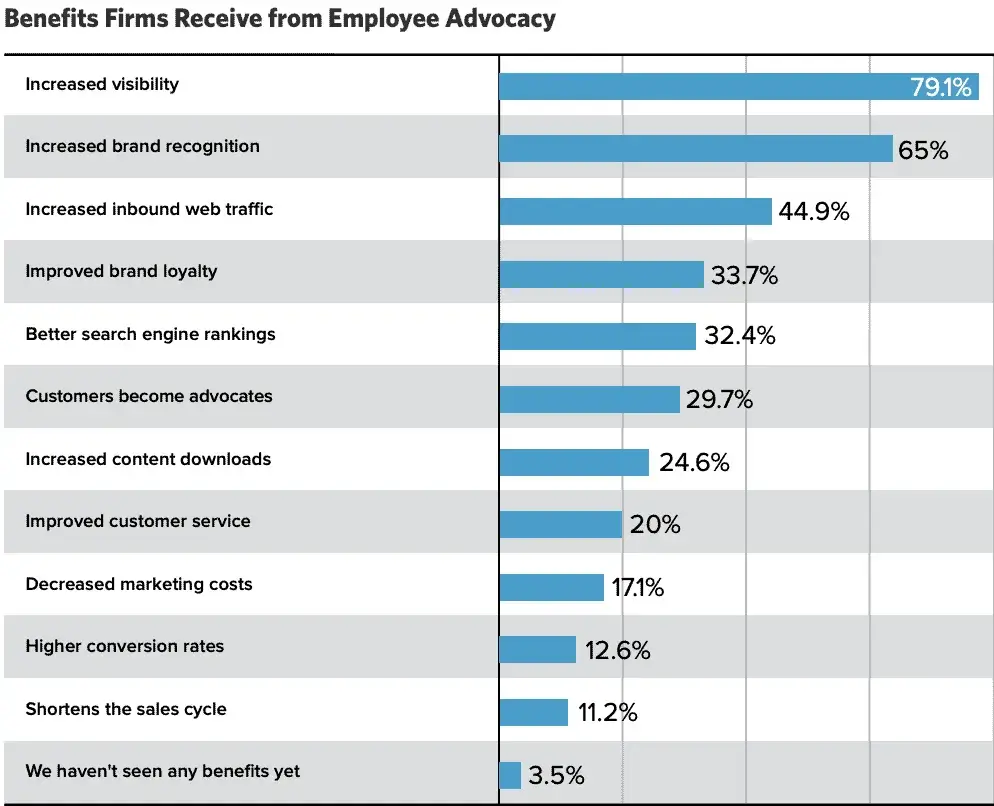
Source: Hinge
Large organizations with many employees can significantly improve marketing and sales performance when they know how to leverage their employees’ existing social media networks.
Here are a few powerful statistics that prove the power of employee advocacy:
- Brand messages reached 561% further when shared by employees vs the same messages shared via official brand social channels (MSLGroup)
- Leads developed through employee social marketing convert 7x more frequently than other leads. (Marketing Advisory Network)
- On average, an employee advocacy program involving 1,000 active participants can generate $1,900,000 in advertising value. (Kredible)
- According to IBM, when a lead is generated through social selling or employee advocacy that lead is 7X more likely to close compared to other lead gen tactics. (Gartner)
- Sales reps using social media as part of their sales techniques outsell 78% of their peers. (Forbes)
- 64% of teams that use social selling hit quota compared to 49% that don’t. (Aberdeen Group)
- 80% of companies believe their sales force would be more effective and efficient if they could leverage social media. (Sales Management Association)
If you are looking to boost your social media marketing strategy by engaging your employees and enabling them to become brand advocates, schedule a Haiilo demo and learn about how other organization use it to reach their sales and marketing KPIs.
Haiilo is an intuitive and mobile-first employee communication, engagement and advocacy platform that empowers social media and marketing teams to enable employees to be the best brand advocates. Its integrations with various social media channels and marketing tools makes employee advocacy easy, fun, rewarding, and engaging – resulting in higher adoption rates and ROIs.









